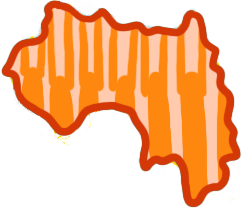Text
In this chapter, we're gonna explicitly cover the standard pronouns of Maninka.
We've, of course, already seen most of them along in the way. But now, we're going to go over them explicitly, so that you both recognize all of them and know when to use which ones and why.
Specifically, I'm gonna cover:
- Singular pronouns
- Plural pronouns
- When to use emphatic pronouns
Singular pronouns
There are three singular pronouns in Maninka:
n
'I'
And:
i
'you'
And:
à
'he/she/it'
(NOTE: I have put a grave accent mark (or "diacritic") above the letter a. This is to mark the fact that the word is, in fact, low tone. I generally don't mark tone in this course, but you'll see why I have done so in just a bit.)
Unlike in English these pronouns do not change depending on whether they are a subject, direct object or a possessive pronoun.
That said, singular pronouns (like the plurals too, as we'll see) have emphatic counterparts. So in fact, the singular pronouns are:
n / ne
'I'
(NOTE: The emphatic form ne can also take the form nde in some areas.)
And:
i / ile
'You'
(NOTE: The second person emphatic pronoun ile may also take the form e or ele in some areas. These are more "Bambara" or "Jula" like forms.)
And:
à / ale
'He/she/it'
Despite the name, emphatic pronouns are generally interchangeable with their "normal" or non-emphatic counterparts. I'll cover a few of the limited contexts in which you should use an emphatic instead of a non-emphatic/regular pronoun in just a bit.
Plural Pronouns
As you might expect, there are three plural pronouns in Maninka:
an
'we'
Then:
álu
'you all'
And:
àlu
'they'
You may have noticed that the second person plural form álu is almost the same as the third person plural form àlu—the only thing that distinguishes them is tone (that is, the relative pitch at which they pronounced).
Here I have used diacritics above the vowels to mark tonal distinctions. This, however, is not generally done in Latin-based Maninka---most often, people write without marking tone at all.
(NOTE: None of this is an issue if you are reading and writing in N'ko since tone is systematically marked in that writing system. This is nice when you are trying to figure out which word an author means or how to pronounce things properly.)
To make these forms emphatic in Maninka, one generally just adds a special focalization marker which is le/ne depending on the sounds of the word that it follows.
For instance:
an / an ne
'we'
Then:
álu / álu le
'you all'
And:
àlu / àlu le
'they'
When to use emphatics
Alright, so if emphatics and non-emphatics are nearly interchangeable why do they have distinct names?
First, it's because they can do different work.
Emphatic pronouns allow you to draw particular attention to a pronoun in a sentence. This a little bit like the way that we use stress in English (e.g., I am your father vs I am your father).
For instance:
Ne ye i fa di.
'I am your father' (instead of just, "I'm your father")
(NOTE: You will learn more about this kind of "Equative" sentence structure soon.)
Second, there are some specific grammatical constructions that require the use an emphatic form. Here's two to give you a sense of what I mean:
-
Presentative constructions using
le/tɛFor instance, if you were looking for your favorite hat and your friend thought they found it, but it wasn't in fact the right one, you'd say:
Ale tɛ. (❌
À tɛ)"That isn't it.''
-
Following
ani('and'; literally, 'it and'). For instance:Ne ani ale ye Kankan. (❌
Ne ani à ye Kankan)'Me and him are in Kankan.'
-
After the question marker
ba(which we will cover explicitly down the road). For instance:– I teri don?
– Àle ba? À ka kɛndɛ! (❌À ba?)– And your friend?
– Him? He is healthy!
There are other cases where it native speakers will naturally use emphatic pronouns. But my advice to you is to not get too focused on trying to memorize when to use or not use emphatics; you will unconsciously pick up the patterns just by listening to and speaking with other people!
Summary
Ayiwa! Here's what we now know about personal pronouns:
-
Personal pronouns have non-emphatic or emphatic forms that are generally interchangeable:
n|ne/nde= Ii|ile= youa|ale= he/she/itan|an ne= weálu|álu le= you allàlu|àlu le= they -
Emphatic forms are used 1) to draw attention to a pronoun; and 2) in some specific grammatical contexts
Vocab
Coming soon n'Ala sɔnna!
- n
- I
- ne/nde
- I (emphatic)
- i
- you
- ile
- you [emphatic]
- à
- he/she/it
- ale
- he/she/it (emphatic)
- an
- we
- an ne
- we (emphatic)
- álu
- you all
- álu le
- you all (emphatic)
- àlu
- they
- álu le
- they (emphatic)
- le
- focus marker
- An ye taa! [An taa!] / An ye wa!
- Let's go!
Vocab list will be here someday!
Flashcards will be here someday!
Exercises
Exercises will be here someday!




